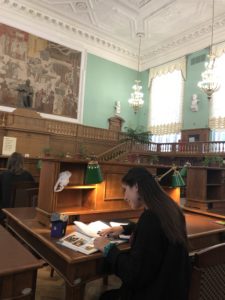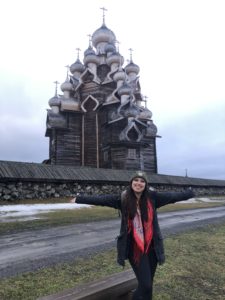
Many students hope to spend their holiday breaks on a warm and sunny beach rather than the middle of a frigid Russian winter, but Gabriella Folsom had a less than typical winter break experience. This January, Folsom went on a two week, all-expenses-paid research trip to Moscow, Saint Petersburg, and Petrozavodsk in order to continue her senior thesis on Kizhi Island. Folsom’s relationship with Russian history and culture began her freshman year when she started studying the Russian language. During the summer of 2018, she traveled to Russia with Dr. Anton Fedyashin’s Carmel Institute summer class to walk history, practice the language, and experience the culture firsthand. “It was my first time out of the country,” says Folsom, “and those two weeks turned out to be one of the most formative experiences I’ve had at AU.” That trip lit a passion for Russian history, and the next spring she spent her semester abroad at the Smolny faculty of Saint Petersburg State University. That summer, she received her second Carmel Institute scholarship, which funded her summer studies at Moscow State University. This research trip marks her fourth time in Russia, and her third trip taken thanks to the generosity of the Carmel Institute and the support of the History Department.

Folsom’s thesis explores Kizhi Island, which lies in Lake Onega not far from Finland, and its complex history under Soviet rule. Its chief claim to fame is the stunning complex of centuries-old churches which dominate the landscape. During the late Stalinist period, the Soviet Union—an atheist state—had to reinterpret Kizhi’s legacy as a religious monument into that of a secular historic and architectural marvel. This trip allowed her to conduct original research at the Russian State Library, Russian National Library, the National Archive of the Republic of Karelia, and the Kizhi Museum itself.
Over the span of two weeks, Folsom travelled from city to city, culminating with a stop on Kizhi Island itself. “It was quite a time,” Folsom recalled with a laugh. “I had to take a hovercraft across the frozen lake, only to find all of the churches padlocked when I got to the island. It’s an open-air museum and it’s in the north, so it makes sense that in the winter they lock stuff up when they don’t think tourists are there.” She eventually caught the eye of a few guards—named Oleg, Oleg, Misha, and Maxim—who took her around the island. “They basically gave me my own private tour. I think they were bored of just standing around in the cold, so they pseudo-adopted me for a few hours. At one point I fell on the ice and Oleg II just fireman-carried me for half a mile. I told him it was unnecessary, but he just found it funny. I’m a big fan.”

As for her academics, Folsom says the History Department at AU has always supported her learning and research interests, and that “the opportunities it has offered [her] have been truly second to none.” Folsom plans to spend the summer after her graduation this spring in Moscow once more, as she has received another scholarship from the Carmel Institute to fund her summer studies. “Very few students are able to experience history the way I have, let alone undergraduates. It really reaffirms that I made the right choice coming to AU,” says Folsom.